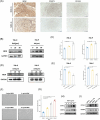Metabolic reprogramming of arachidonic acid in clear cell renal carcinoma promotes an immunosuppressive microenvironment by activating MDK signaling pathway
- PMID: 40802073
- PMCID: PMC12350486
- DOI: 10.1007/s10238-025-01807-8
Metabolic reprogramming of arachidonic acid in clear cell renal carcinoma promotes an immunosuppressive microenvironment by activating MDK signaling pathway
Abstract
Metabolic reprogramming is a key feature of clear cell renal cell carcinoma (ccRCC), and metabolic abnormality can lead to significant changes in gene expression, resulting in the immunosuppressive microenvironment. In this study, we used a combination of single-cell RNA sequencing and bulk RNA sequencing to investigate the relationships between ccRCC metabolic reprogramming and immune exhaustion. Metabolic subtypes of ccRCC patients were constructed using bulk RNA sequencing. Tumor cells of different metabolic subtypes were analyzed and extracted by the Scissor algorithm, using single-cell RNA sequencing. The molecular mechanisms of abnormal metabolic regulating tumor immunity were explored using cell-cell communication analysis. In addition, the correlations between relevant molecules and immune exhaustion signals were verified in ccRCC by immunohistochemistry. The molecular mechanisms of metabolic abnormalities leading to immune exhaustion were validated via Western blotting, ELISA, cell co-culture and immunotherapy models. ccRCC patients can be divided into MT1 and MT2 metabolic subtypes. The MT2 subtype has a poorer prognosis and lower response to immunotherapy. Abnormal metabolism of arachidonic acid is a prominent feature of the MT2 subtype, and activates the MDK signaling pathway. As a secreted protein, MDK can further recruit immunosuppressive cells, such as Treg, Tex, and TAM. Blocking the arachidonic acid COX metabolic pathway significantly reduces the expression and secretion levels of MDK, thereby reprogramming the tumor microenvironment to promote anti-tumor immunity. Abnormal metabolism of arachidonic acid plays an important role in promoting immune exhaustion by activating the MDK signaling pathway. MDK may serve as an important biomarker for predicting the immune therapy response in ccRCC. By reducing MDK secretion, targeting blockade of arachidonic acid metabolism may be an effective treatment strategy to enhance the efficacy of immunotherapy in ccRCC.
Keywords: Arachidonic acid; Clear cell renal cell carcinoma; Immunotherapy combined therapy; MDK; Metabolic reprogramming.
© 2025. The Author(s).
Conflict of interest statement
Declarations. Conflict of interest: The authors declare no competing interests.
Figures








Similar articles
-
NME4: A novel metabolic-associated biomarker for prognosis prediction and immunotherapy response evaluation in clear cell renal cell carcinoma.Mol Immunol. 2025 Aug;184:149-163. doi: 10.1016/j.molimm.2025.06.011. Epub 2025 Jul 1. Mol Immunol. 2025. PMID: 40602220
-
COL6A2 in clear cell renal cell carcinoma: a multifaceted driver of tumor progression, immune evasion, and drug sensitivity.J Transl Med. 2025 Aug 6;23(1):875. doi: 10.1186/s12967-025-06793-9. J Transl Med. 2025. PMID: 40770761 Free PMC article.
-
Multi-omics analysis reveals the role of ribosome biogenesis in malignant clear cell renal cell carcinoma and the development of a machine learning-based prognostic model.Front Immunol. 2025 Jun 26;16:1602898. doi: 10.3389/fimmu.2025.1602898. eCollection 2025. Front Immunol. 2025. PMID: 40642093 Free PMC article.
-
Cancer-associated fibroblasts in clear cell renal cell carcinoma: functional heterogeneity, tumor microenvironment crosstalk, and therapeutic opportunities.Front Immunol. 2025 Jun 4;16:1617968. doi: 10.3389/fimmu.2025.1617968. eCollection 2025. Front Immunol. 2025. PMID: 40534854 Free PMC article. Review.
-
Systemic treatments for metastatic cutaneous melanoma.Cochrane Database Syst Rev. 2018 Feb 6;2(2):CD011123. doi: 10.1002/14651858.CD011123.pub2. Cochrane Database Syst Rev. 2018. PMID: 29405038 Free PMC article.
References
-
- Sung H, et al. Global cancer statistics 2020: GLOBOCAN estimates of incidence and mortality worldwide for 36 cancers in 185 countries. CA Cancer J Clin. 2021;71:209–49. 10.3322/caac.21660. - PubMed
-
- Siegel RL, Miller KD, Fuchs HE, Jemal A. Cancer statistics, 2022. CA Cancer J Clin. 2022;72:7–33. 10.3322/caac.21708. - PubMed
-
- Barata PC, Rini BI. Treatment of renal cell carcinoma: current status and future directions. CA Cancer J Clin. 2017;67:507–24. 10.3322/caac.21411. - PubMed
MeSH terms
Substances
LinkOut - more resources
Full Text Sources
Medical
Research Materials

